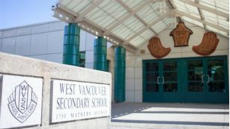
学園ブログ

- ホーム
- 世界へはばたく
世界へはばたく

2018年10月23日
日本の学校とカナダの学校の違い

はじめまして。雲雀丘学園小学校の新しい英語教員、デーン・スコルフィールドです。今回、この機会を使って、自己紹介とともに日本とカナダの学校システムの違いについてお話しようと思います。
私は、8月にこの雲雀丘学園小学校に着任しました。カナダのブリティッシュコロンビア州バンクーバーより、JETプログラム(外国に住む方に日本に来ていただき、日本の子どもたちに英語を教えることを通して、文化交流をしていただくという国の制度)を利用して来ました。去年、私は、カナダの中学・高校で、中2・中3・高1・高2(カナダでは、8年生・9年生・10年生・11年生と言います。)に英語と社会を教えていました。この雲雀丘に来てから、カナダと日本の学校の似ているところと違うところをいくつか見つけました。
まず、違う点についてです。はじめに気づいたのが、雲雀丘では、学校生活の中で時間を知らせるのに音楽が流れることです。これらの歌の多くが、北アメリカで人気のクラシック音楽ばかりであったことにも驚きました。カナダでは、ほとんどの学校がブザーを使って時間を知らせます。雲雀丘のように、音楽を使った方が、1つの活動から次の活動に移るのが楽しそうだな、と感じました。
もう1つの違いが、掃除のことです。日本では、生徒と先生で学校を掃除します。一方でカナダでは、清掃員がします。私は、生徒に学校をきれいに保ち続けようという責任を持たせることは良い考えだと思います。カナダでもこの光景を見てみたいと思いました。また、日本の学校がいつもきれいな理由の1つとして、全員が上靴を履いていることも挙げられると思います。カナダでは、学校の内外で履く靴は一緒です。
また、カナダと日本の先生の違いも見つけました。そのうちの1つが、服装です。カナダでは、先生たちの服装がかなりカジュアルなのです。特に暖かい時期は、先生たちがカジュアルなシャツに短パン、だなんて光景もめずらしくありません。冬の期間も、先生はジーンズを履いており、男性の先生がスーツを着てネクタイをしめている光景なんてごく希です。女性の先生がきちんとしたワンピースを着ているのも希で、多くの先生がラフなパンツスタイルを好んでいます。
先生と生徒が学習をする教室も全然違います。日本では「教員室」があり、そこで仕事をしたり、子どもたちと顔を合わせたりしています。一方でカナダでは、多くの先生が教室で仕事をします。「教員室」という場所はありますが、そこは基本的に、昼食や休憩を取る場所であり、生徒の入室は禁止されています。
日本とカナダの子どもたちの様子で異なるところもあります。例えば、多くの日本の学生は制服を着ています。私は、雲雀丘の制服の質の良さと洗練された見た目に感銘を受けました。雲雀丘のランドセルにしてもそうです。カナダでは、ほとんどの生徒が安価なリュックサックを使っており、2年おきくらいに新しいものに買い換えなければなりません。さらに言うと、ほとんどのカナダの学校では制服がありません。同時に、カナダの生徒は名札もつけません。
最後に、日本の学校の生徒の通学方法はカナダとかなり違っています。日本では多くの生徒が電車で通学したり、学校によっては自転車で通ったりしています。これに対して、カナダでは、ほとんどの生徒がスクールバスか保護者の車で通学します。
また、私は気象状況の違いも経験しました。バンクーバーでは、夏に台風のような嵐を経験することがありません。しかし、冬に嵐に見舞われることがしばしばあり、雪のために休校になることがあります。さらに、カナダでは、気温がマイナス20度を下回ると休校になります。8月に雲雀丘学園に着任して以来、何度か台風のために学校が休校になるということを経験しました。これは、カナダでは経験できない現象です。
このように、雲雀丘学園小学校とカナダの学校とでは違うところもたくさんありますが、似ているところもあります。日本の先生方は、カナダと同じように、生徒のために、子どもたちの学びのために非常に情熱を持って日々指導されているということです。時に乗り越えなければならない壁にぶち当たることもありますが、日本の生徒もカナダの生徒も、元気いっぱい、熱心で、いつも共に学ぶことを誇りに思えます。
こういった理由から、私は、雲雀丘学園で教えるということに名誉に思うと同時に、今年度の残りの日々が楽しみでなりません。



Hello, my name is Dane Scholefield! I am a new English teacher at Hibarigaoka Gakuen Elementary School. I would like to use this opportunity to introduce myself and discuss some differences between the Japanese and Canadian school systems.
I started working at Hibarigaoka Gakuen Elementary School in August. I came here from Vancouver, British Columbia, Canada as part of the JET (Japanese Exchange and Teaching) Program. Last year I worked in a Canadian junior/senior high school where I taught English and Social Studies at the grade 8, 9, 10 and 11 levels. Since the start of my teaching at Hibarigaoka I have noticed some interesting similarities and differences between the Canadian and the Japanese school systems.
There are some interesting differences between the school environment of Hibarigaoka and Canadian schools. One of the first differences I have noticed is Hibarigaoka’s use of songs to mark the beginning and end of classes. I recognize many of these songs as popular classics from North America! In Canada, most schools use a buzzer to mark the beginning and end of classes. I find that the use of music at Hibarigaoka is a more pleasant way to transition between activities.
Another difference between the physical environment of Canadian and Japanese schools is how schools are cleaned. In Japan, students and teachers clean the school, whereas in Canada janitors clean the school. I think that it is a great idea to have students take responsibility for keeping the school clean. This is something I would like to see in Canadian schools as well. One of the reasons why Japanese schools are so clean is that people wear inside shoes in the school. In Canada, people the same shoes inside and outside of the school.
I have also seen some differences between teachers in Canada and Japan. One difference is the style of dress. In Canada, teachers tend to dress quite casually. In the warm months, it is not unusual to see teachers wearing shorts, and casual shirts. In the winter months, teachers often wear jeans and men rarely suits or ties. Women rarely wear dresses, and they usually prefer to wear pants. Also, the location of where teachers and students work is different between Canada and Japan. In Japan, there is a central room for teachers to work and meet with students, whereas in Canada, teachers mostly work from their classrooms. Teachers do have a staff room, but this is primarily used for lunch breaks and students are not permitted to enter.
There are some interesting differences between Japanese and Canadian students as well. For example, many Japanese students wear uniforms. I have been impressed by the quality and sharp appearance of Hibarigaoka students` uniforms! For example, I was surprised to learn about the quality of Hibarigaoka backpacks. In Canada most students use inexpensive backpacks that must be replaced every year or two. In addition, most Canadian students do not wear uniforms. They tend to dress very casually, and there are very few rules about what students should wear. As well, Canadian students do not wear name tags, whereas Japanese students do. Finally, the way students come to school in Japan is quite different from the way Canadian students come to school. In Japan, many students take the train, or ride a bike. In Canada, most students come to school on a school bus, or are driven by their parents.
I have also experienced differences in the way weather impacts school. In Vancouver, we do not experience strong storms in the summer. However, we do have winter storms, and sometimes we cancel school due to snow. Other parts of Canada will cancel school if the temperature dips below minus 20 degrees Celsius. Since starting my teaching at Hibarigaoka in August, we have been forced to cancel classes a few times due to Typhoons. This is a weather phenomenon we do not have in Canada.
Overall, despite the differences between Hibarigaoka Gakuen Elementary School and Canadian schools, some key similarities stand out. Teachers in Japan, like those in Canada, are dedicated professionals who are devoted to their students and passionate about student learning. Students in Japan and Canada, while sometimes challenging, are energetic, enthusiastic and always a privilege to work with. For these reasons, it is a great honor to teach at Hibarigaoka Gakuen Elementary School, and I look forward to the rest of the school year.
小学校教諭 デーン・スコルフィールド
